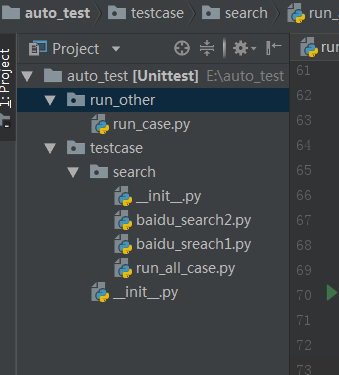一、Unittest单元测试框架简介
Unitest是Python下的一个单元测试模块,是Python标准库模块之一,安装完Python后就可以直接import该模块,能在单元测试下编写具体的测试用例脚本,并调用模块封装好的方法,实现测试用例的执行、测试场景的恢复,甚至能批量采集测试用例脚本、批量运行测试脚本用例、控制执行顺序等,依托于Unittest模块,可以高效的组织测试用例编写、测试用例脚本的采集管理以及脚本运行的执行控制等。Unitest单元测试框架主要包含如下几个重要的逻辑单元:
1.测试固件(test fixture)
一个测试固件包括两部分,执行测试代码的前置条件和测试结束之后的场景恢复,这两部分一般用函数setUp()和tearDown()表示。简单说,就是平时手工测试一条具体的测试用例时,测试的前置环境和测试结束后的环境恢复。
2.测试用例(test case)
unittest中管理的最小单元是测试用例,就是一个测试用例,包括具体测试业务的函数或者方法,只是该test case 必须是以test开头的函数。unittest会自动化识别test开头的函数是测试代码,如果你写的函数不是test开头,unittest是不会执行这个函数里面的脚本,这个千万要记住,所有的测试函数都要test开头,记住是小写的哦。
3.测试套件 (test suite)
就是很多测试用例的集合,一个测试套件可以随意管理多个测试用例,该部分用来实现诸多测试用例的采集,形成一套测试用例集。
4.测试执行器 (test runner)
test runner是一个用来执行加载测试用例,并执行用例,且提供测试输出的一个逻辑单元。test runner可以加载test case或者test suite进行执行测试任务,并能控制用例集的执行顺序等。
从Unitest单元测试框架的基本逻辑单元设计来看,很明显可以看到它包含了用例的整个生命周期:用例的前置条件、用例的编写、用例的采集、用例的执行以及测试执行后的场景恢复。
二、首次使用Unittest模块
下面以打开百度,进行搜索,创建一个名为baidu_search.py的脚本文件,编写百度搜索分别python2和python3的测试用例,代码如下:
'''
Code description:
Create time:
Developer:
'''
# -*- coding: utf-8 -*-
import time
import unittest
from selenium import webdriver
class Search(unittest.TestCase):
def setUp(self):
"""
测试前置条件,这里要搜索的话就是先得打开百度网站啦
"""
self.driver = webdriver.Ie()
self.driver.maximize_window()
self.driver.implicitly_wait(5)
self.driver.get("https://www.baidu.com")
def tearDown():
"""
测试结束后环境复原,这里就是浏览器关闭退出
"""
self.driver.quit()
def test_search1(self):
"""
这里一定要test开头,把测试逻辑代码封装到一个test开头的方法里。
"""
self.driver.find_element_by_id('kw').send_keys('python2')
self.driver.find_element_by_id('su').click()
time.sleep(1)
try:
assert 'python2' in self.driver.title
print('检索python2完成')
except Exception as e:
print('检索失败', format(e))
def test_search2(self):
"""
这里一定要test开头,把测试逻辑代码封装到一个test开头的方法里。
"""
self.driver.find_element_by_id('kw').send_keys('python3')
self.driver.find_element_by_id('su').click()
time.sleep(1)
try:
assert 'python3' in self.driver.title
print('检索python3完成')
except Exception as e:
print('检索失败', format(e))
if __name__ == '__main__':
unittest.main()
在PyCharm中运行上面代码,我们会发现浏览器打开关闭了两次,分别检索了python2关闭浏览器,然后检索python3关闭浏览器。
这个效果显然不是我们希望的,我们希望检索完python2后,不用关闭浏览器继续检索python3,Unittest有相关的设置吗?答案是肯定的,我们对以上代码做下调整修改,注意对比不同的地方,然后运行就达到我们想要的效果
'''
Code description:
Create time:
Developer:
'''
# -*- coding: utf-8 -*-
import time
import unittest
from selenium import webdriver
class Search(unittest.TestCase):
@classmethod
def setUpClass(cls):
"""
测试前置条件,这里要搜索的话就是先得打开百度网站啦
"""
cls.driver = webdriver.Ie()
cls.driver.maximize_window()
cls.driver.implicitly_wait(5)
cls.driver.get("https://www.baidu.com")
@classmethod
def tearDownClass(cls):
"""
测试结束后环境复原,这里就是浏览器关闭退出
"""
cls.driver.quit()
def test_search1(self):
"""
这里一定要test开头,把测试逻辑代码封装到一个test开头的方法里。
"""
self.driver.find_element_by_id('kw').send_keys('python2')
self.driver.find_element_by_id('su').click()
time.sleep(1)
try:
assert 'python2' in self.driver.title
print('检索python2完成')
except Exception as e:
print('检索失败', format(e))
def test_search2(self):
"""
这里一定要test开头,把测试逻辑代码封装到一个test开头的方法里。
"""
self.driver.find_element_by_id('kw').clear() # 清空之前输入的python2
self.driver.find_element_by_id('kw').send_keys('python3')
self.driver.find_element_by_id('su').click()
time.sleep(1)
try:
assert 'python3' in self.driver.title
print('检索python3完成')
except Exception as e:
print('检索失败', format(e))
if __name__ == '__main__':
unittest.main()
三、Unittest模块批量加载和管理用例
以上对于Unittest框架,我们好像只用到了测试固件、测试用例两个逻辑单元的使用,接下来问题又来了:我们日常项目中的测试案例肯定不止一个,当案例越来越多时我们如何管理这些批量案例?如何保证案例不重复?如果案例非常多(成百上千,甚至更多)时如何保证案例执行的效率?
来看一下在unittest框架中如何管理批量用例:

手动添加采集指定的测试用例集用法:先在PyCharm中新建如下项目层级:

其中baidu_search1还是上面调整修改过的代码,然后编辑run_case.py文件,代码如下:
'''
Code description: 执行add 的测试用例集
Create time:
Developer:
'''
# -*- coding: utf-8 -*-
from testcase.sreach.baidu_sreach1 import Search # 将baidu_sreach.py模块导入进来
import unittest
suite = unittest.TestSuite() # 构造测试用例集
# suite.addTest(Search("test_search1"))
suite.addTest(Search("test_search2")) # 分别添加baidu_sreach1.py中的两个检索的测试用例
if __name__ == '__main__':
runner = unittest.TextTestRunner() # 实例化runner
runner.run(suite) #执行测试
这样运行run_case.py,就只执行了在百度中搜索python3这条用例,手动添加指定用例到测试套件的方法是addTest(),但是很多时候我们写了很多测试脚本文件,每个脚本中有多个test,,如果还是使用addTest()方法就不行了,我们希望能获取所有的测试集,并全部执行。然后编辑run_all_case.py文件,编写如下代码:
'''
Code description: TestLoader所有测试case
Create time:
Developer:
'''
# -*- coding: utf-8 -*-
import time
import os.path
import unittest
from selenium import webdriver
class Search(unittest.TestCase):
@classmethod
def setUpClass(cls):
"""
测试前置条件,这里要搜索的话就是先得打开百度网站啦
"""
cls.driver = webdriver.Ie()
cls.driver.maximize_window()
cls.driver.implicitly_wait(5)
cls.driver.get("https://www.baidu.com")
@classmethod
def tearDownClass(cls):
"""
测试结束后环境复原,这里就是浏览器关闭退出
"""
cls.driver.quit()
def test_search1(self):
"""
这里一定要test开头,把测试逻辑代码封装到一个test开头的方法里。
"""
self.driver.find_element_by_id('kw').send_keys('python2')
self.driver.find_element_by_id('su').click()
time.sleep(1)
try:
assert 'python2' in self.driver.title
print('检索python2完成')
except Exception as e:
print('检索失败', format(e))
def test_search2(self):
"""
这里一定要test开头,把测试逻辑代码封装到一个test开头的方法里。
"""
self.driver.find_element_by_id('kw').clear() # 清空之前输入的python2
self.driver.find_element_by_id('kw').send_keys('python3')
self.driver.find_element_by_id('su').click()
time.sleep(1)
try:
assert 'python3' in self.driver.title
print('检索python3完成')
except Exception as e:
print('检索失败', format(e))
def test_search3(self):
"""
这里一定要test开头,把测试逻辑代码封装到一个test开头的方法里。
"""
self.driver.find_element_by_id('kw').clear() # 清空之前输入的python3
self.driver.find_element_by_id('kw').send_keys('hello world')
self.driver.find_element_by_id('su').click()
time.sleep(1)
try:
assert 'hello world' in self.driver.title
print('检索hello world完成')
except Exception as e:
print('检索失败', format(e))
case_path = os.path.join(os.getcwd()) # 在当前目录中采集测试用例
print(case_path)
all_case = unittest.defaultTestLoader.discover(case_path, pattern="test*.py", top_level_dir=None) # 采集所有test开头的测试用例
print(all_case)
if __name__ == '__main__':
runner = unittest.TextTestRunner() # 实例化runner
runner.run(all_case) # 执行测试
获取所有的测试用例集使用的是discover()方法,在PyCharm中运行该脚本就如下:

以上就完成了在Python Unittest单元测试框架下编写测试用例脚本,并使用其提供的多种方法来批量管理测试用例集并并执行。